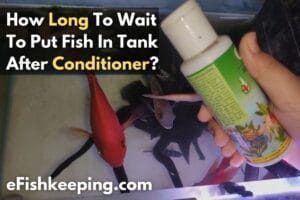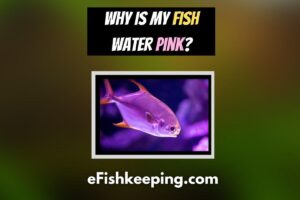You’ve just changed the water in your aquarium and saw that all the fish are swimming at the top of the tank.
Sounds familiar?
Quick Takeaways:
- If fish is hanging out at the top and gasping, it’s mainly because of the following reasons: Untreated Water, Temperature Fluctuation, Change In Water Parameters, and Lack of Dissolved Oxygen.
- The best and the most effective solution to prevent any fish from dying after you do water change is to treat the water with a water conditioner like Seachem Prime. Water conditioners are products that are designed to make the tap water safe for the fish by neutralizing components present in water like Chlorine, that can be harmful to the fish.
- Chlorine is particularly known to affects the gills of the fish and make them gasp. (Usually, that’s why you see them struggling to breathe, staying at the top of the tank)
- So the next time you do any water change, ensure the water is first treated with conditioner before you add it to the aquarium. And also, ensure the temperature of the water is not too hot – as warmer water hold less dissolved oxygen.
Read on till the end to explore more about why fish swim to the top of the tank right after you do water change.
Why Fish Swim To The Top Of The Tank After Water Change
One of the common reasons for fish swimming to the surface of the water after a water change is that there’s a lack of dissolved oxygen. You can solve this easily with an air stone and/or oxygen pump. But, it could also have to do with poor water parameters; in which case you’ll have to do further investigation.
However, it’s important to observe your fish since there are some species that enjoy going to the top from time to time. This means it’s not always a bad thing or something for you to have concern over.
Observe the Fish
More often than not, the issue of fish swimming up to the surface of the tank means there isn’t enough oxygen present.
But, before you go adding more oxygen to the tank, you should inspect all the signs going on and how the fish are behaving.
If they’re moving around and swimming fine, then they could just be at the top because they feel like it. Actually, several species of fish like to hang around at the top of an aquarium.
- Brown Pencilfish
- Silver Hatchetfish
- Bettas
- Cichlids
- Golden Wonder ; Clown Killfish
- African Butterflyfish
- Furcata Rainbowfish
- Danios
- Snails
- Halfbeaks
- Gouramis
Fish Showing Signs of Struggle or Illness
When they float to the top and show clear signs of struggle while gasping for air, then the fish may be suffering from hypoxia or swim bladder.
Hypoxia is when the fish doesn’t have any capacity to breathe due to lack of oxygen. This will be especially true if the gills are red.
Swim bladder is an infection common to most fish and causes them to swim close to the surface. They will even appear to swim upside down or sideways. It means they’re constipated due to too much food, overcrowding or not changing water frequently enough.
A good treatment for this is to give the fish oranges, melon or green peas. In more severe cases, you may want to get antibiotics specifically for fish.
Check Water Parameters
Do the standards first, checking for the typical components that make a tank difficult for fish to live in. When nitrites are over 3ppm, nitrates are higher than 100 and ammonia above zero, you will have to do another water change.
This also includes salinity (for saltwater tanks), pH balance and water hardness.
However, if you just changed the water, then something in the tank is keeping this spike up.
For instance, there could be a dead fish nestled somewhere, like in a hidden area of the substrate or in the water filter.
Alternatively, you may need to clean out the substrate because there’s too much food sitting at the bottom.
If the parameters check out fine, then measure the oxygen content at the bottom, middle and top of the tank with an oxygen meter.
Read: Why Is My Fish Water Pink? (7 Reasons + How To Fix!)
Aerating the Water
If it reads anything less than 4ppm, you will need to aerate the water. There are four ways to get more oxygen into the aquarium for your fish:
- If your water filter or pump is your main source of oxygen, move it through your tank and take another oxygen reading.
- Some aquarists suggest drilling hole into pebbles and slowly dropping them into the tank, one-by-one. This helps bring oxygen to the lower parts of the aquarium.
- Invest in an oxygen pump along with an air stone (link goes to Amazon). Such devices are the surest way to get air into your tank. While these are pricier, they are a more surefire way to guarantee good oxygen flow.
- You could also try adding more live plants (link goes to Amazon) to the tank. This is useful if you have fish that don’t like strong water currents.
However, you want to ensure you don’t over-oxygenate the tank. Too much oxygen can have its own kinds of problems as well. Having said that, understand that most tanks are under-oxygenated.
Water Temperature Is Too High
Another reason why the fish may be swimming toward the top of the tank is that the temperature of your water change was far too warm. It’s imperative that you ensure the water is at room temperature.
This is because any temperature above 68°F to 70°F will reduce any oxygen molecules present.
Do not take this as an okay to use colder water either. If the water sits below room temperature, it can cause shock to the fish. You will increase the chances of death for more fragile and delicate species.
Of course, it will all impinge on your fishes’ preferences for water. So, before you change it out, use a thermometer to ensure the water is at the right temperature.

Check This Here (on Amazon)
In A Nutshell
When you find your fish often coming to the surface after a water change, it’s crucial you observe the fish and check the proper parameters of the water.
In most cases, there isn’t enough oxygen present to keep them happy or you have added untreated water. Generally, adding air stones and using a good water conditioner like Seachem Prime to treat the tap water should solve the issue. (Check out this guide to learn all about Seachem Prime and its dosage.)
Finally, if you added the water at improper temperature, ensure you add water at the right temperature from next time. I hope this helps!
Read Next: Can A Bottled Water Be Added In A Fish Tank?
Hi! I’m Praveen Ghoshal, the founder of eFishkeeping.com. Inspired by my Dad, I got interested in fishkeeping when I was a kid. Since then, I have been involved with this hobby. Currently, I have 3 fish tanks at our home, and I enjoy this hobby with my full family. Read more about me here.







![Too Much Oxygen In Fish Tank? [All You Need To Know!] can-you-have-too-much-oxygen-in-fish-tank](https://efishkeeping.com/wp-content/uploads/2022/06/Can-You-Have-Too-Much-Oxygen-In-Fish-Tank-Explained-300x200.jpg)